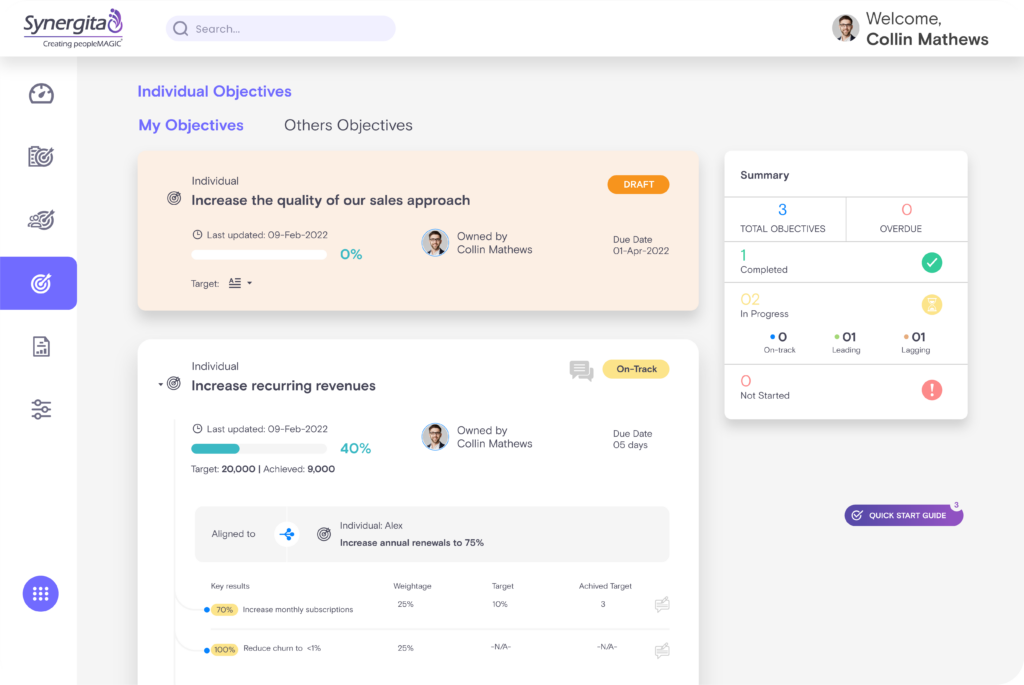How To Create a Complete OKR Checklist: A Step-by-Step Guide
As you know, market competition is at an all-time high. With the transformation of the business environment and the rise of start-ups, it is imperative for companies that want to succeed to set ambitious yet achievable objectives. More importantly, these objectives must be quantifiable so you can assess and follow their progress in real-time.
Are you looking to improve your individual and organizational goals, or do you want to recommend a new management tool to other leaders? For all these concerns, OKRs will work.
OKRs are meaningfully framed Objectives and Key Results that are established and tracked to improve business performance. The purpose of OKR is to create future objectives and track those objectives with Key Results.
Objectives are the overarching goals of an organization, department, or person, and Key Results are a measurement of those objectives.
Most fast-growing organizations want to develop their business and view OKRs as the best solution for all their management needs. However, applying this sound framework for the first time can be challenging. This is why an OKR checklist is necessary.
What is an OKR checklist?
Most companies establish yearly targets and goals for each department and team member. However, due to inefficient processes, most of these objectives remain unachieved.
Adopting an OKR framework reduces the likelihood of failure. It aligns the company and tracks the progress of definable goals. The framework also divides the goals into subsidiary focal areas for easier tracking.
Generally, implementing OKRs entails altering the whole organization’s attitude to work. A business operating with a specific work culture may find it easier said than done.
An OKR checklist can help businesses make this transition as smooth as possible. It is intended to help everyone in the company grasp the importance and power of OKRs. It also helps them become acquainted with this structure by listing each key result. The checklist is necessary to ensure everyone is on board with the idea and is on the same page with the objectives.
Before implementing OKRs in your company, you must train your employees on the basics. This will help them recognize your efforts and the need for change.

What are the types of OKR checklists?
OKR checklists are divided into three types.
- The preparation checklist includes a guideline to assist team leaders in communicating the benefits of the OKR framework to the company.
- The brainstorming checklist encourages the team to consider applicable OKRs and potential ways to accomplish them.
- The action checklist will help your team create a new, improved structure. It guarantees that your team applies OKRs and tracks their progress regularly.
A step-by-step guide to creating a complete OKR checklist
After all team members realize the importance of OKRs, the next step is to develop an OKR checklist to help implement these OKRs.
1. Clarify the Purpose
Knowing the vision you are working towards makes it easier to understand your role and purpose in a company.
- Begin with the values, vision, and mission of the company.
- Explain the company’s long-term objective
- Define the business objectives.
- Develop a business strategy and plan for achieving your objectives.
- Help team members in developing goals that are in line with the objectives of the company.
2. Have a brainstorming session
Involving your team in the planning and discussion is an excellent way to keep them motivated.
- Hold a brainstorming session with your employees to get their opinions.
- Discuss which areas should be prioritized.
- Explain how they should set their goals – simple, practical, and inspirational.
- Ask about their objectives for the future quarter or year.
- Ask your employees about the outcomes they hope to attain through these goals.
- Encourage them to divide these Key Results into small measurable units that may be used to measure progress in real-time.
3. Establish individual objectives
A leader must help team members determine individual goals.
Here are some questions to get you started:
- What makes a specific objective important to your team?
- Is the objective in line with the general objectives of the company?
- What are the limitations to meeting the objectives?
- What is the time restriction for finishing the objective?
- Can you break the objective down into smaller, quantifiable goals?
4. Devise Key Results for the objectives
To keep team members motivated, encourage them to set individual quantifiable Key Results. Consider the following questions while setting Key Results:
- Is there a specific Key Result for each objective?
- Is the particular objective attainable?
- Is the Key Result measurable?
5. Planning and time management
Planning the OKR cycle for the entire organization is essential. Here are things that you should consider:
- Individual, team, and organizational goals should all be aligned.
- The entire team should be aware of the period for which certain OKRs are set.
- Tell them when and how they will be evaluated on their performance.
- Discuss the challenges that may arise during the process and how to overcome them.
- To ensure the task is completed on time, you should provide the necessary resources in advance.
6. Schedule regular check-in
When working, routine check-ins avoid misunderstanding and bridge communication gaps.
- Hold frequent meetings to track progress.
- Examine if work processes are prioritized correctly.
- Check to see if the plan is working as planned.
- Investigate pain spots and how to resolve them successfully.
7. Check for underperforming OKRs
It is impossible to predict all difficulties from the start. These questions can help you identify unaddressed issues:
- Is everyone on the same page about the team’s and individuals’ goals?
- Do the teams understand each other’s goals?
- How does work overlap?
8. Planning for the next cycle
Based on the previous cycle’s achievements and shortcomings, you and your team should work together to make the following cycle a more significant success.
- Check to see if you need to increase or decrease the number of OKRs for your team’s performance.
- Identify the problems from the previous cycle and come up with solutions to them.
- If they did not meet some critical objectives in the previous cycle, they could be carried over into the next cycle.
Conclusion
The OKR framework simplifies engaging all team members, setting priorities, and aligning with business objectives. Because of the measurable results, team members can assess how they contribute to the company’s goals.
Even with a comprehensive OKR checklist, applying and tracking the many steps might take a lot of work. Synergita’s OKR Management Software is the best method for overcoming these obstacles. The user-friendly OKR app lets you build OKRs using the OKR templates and schedule weekly reviews and check-ins.
The OKR dashboard allows you to monitor progress visibly and take action. Sign Up today to reach new heights of business success.
Also Read:

